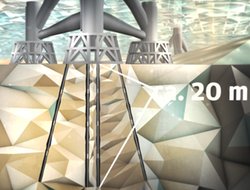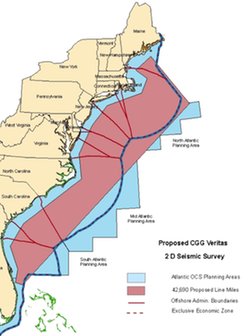 A 75-turbine wind farm that would span parts of three Michigan counties will be 9 turbines smaller, after Merritt Township Planning Commission voted to not issue permits to allow construction of turbines. The Merritt commission did grant permission for a substation and underground cables that are part of the wind farm’s infrastructure, but decided against allowing nine 466-foot turbines. Commissioners visited wind turbines in three nearby townships, and apparently based their decision primarily on concern for rural quality of life in their township. “They studied it thoroughy,” said John McQuillan, Merritt Township attorney. “That’s why the Planning Commission is appointed to make this decision.”
A 75-turbine wind farm that would span parts of three Michigan counties will be 9 turbines smaller, after Merritt Township Planning Commission voted to not issue permits to allow construction of turbines. The Merritt commission did grant permission for a substation and underground cables that are part of the wind farm’s infrastructure, but decided against allowing nine 466-foot turbines. Commissioners visited wind turbines in three nearby townships, and apparently based their decision primarily on concern for rural quality of life in their township. “They studied it thoroughy,” said John McQuillan, Merritt Township attorney. “That’s why the Planning Commission is appointed to make this decision.”
Merritt adopted an ordinance in 2010 requiring a quarter-mile setback from homes and roadways; a local community group had been pushing for an increase to a half-mile. NextEra, the wind farm developer, had removed nine turbines from their plan, and moved nine others to meet the quarter-mile standard. “It’s astonishing,” said a NextEra spokesperson. “We showed them how we had adhered to all of the regulations of their ordinance, and they completely disregarded the rules that they had set in place.”
At the Planning Commission meeting, a petition was presented containing 453 signatures from local residents opposing construction in their township. While health and property value concerns were raised, at the meeting Annette DuRussel stressed simpler quality of life issues, stressing that “Merritt Township residents have the right to a good night’s sleep, a scenic view that is currently unobstructed – the list goes on and on.”
“The community is divided and the issue is getting hotter as the date to make a decision gets closer,” said Dave Schabel, Merritt Township supervisor, before the meeting. “It’s very controversial and has torn families apart, turned brother against brother….It’s hard for them,” Schabel said, referring to the Planning Commission. “They’re just average people in a pretty hot spot, and they are trying to get as much information as possible to make an informed decision — hopefully we can put the community back together.”
Dee VanDenBoom, Merritt Township resident, had been looking forward to seeing a turbine on his neighbors property, and felt that those opposing it were only “thinking of their own comfort;” he was disappointed with the decision but is hoping the community can move forward.”We’re peacemakers,” VanDenBoom said. “I hope that people can come together as friends and neighbors again.”
The comment of another local supporter, who will be hosting turbines near his home in a neighboring township, points to one of the factors in the Merritt commission’s decision: so many people living in the vicinity of the wind farm. “Merritt is different than Gilford because there are more houses in the area, but still, I’m disappointed.”
Good local coverage:
Prior to the meeting here; initial article after the meeting here; and followup to the decision here.
Related: Another northern Michigan town, Lake Township, voted down a proposed wind farm ordinance on primary day, February 28; the ordinance included setbacks of 1500 feet and sound limits of 45dB, both fairly typical of many US siting standards.


 I’ve yet to dig into the PEIS to examine its alternatives or proposed mitigation measures, but a quick look at maps illustrating applications already received from oil and gas exploration companies affirms that the entire east coast could become an active seismic survey zone (the map at left is one of nine applications; there is much overlap among them).
I’ve yet to dig into the PEIS to examine its alternatives or proposed mitigation measures, but a quick look at maps illustrating applications already received from oil and gas exploration companies affirms that the entire east coast could become an active seismic survey zone (the map at left is one of nine applications; there is much overlap among them). I’ve also been invited to participate in a small, invitation-only symposium being convened by NOAA (National Oceanic and Atmospheric Administration) and BOEM (Bureau of Ocean Energy and Management) to gather feedback on
I’ve also been invited to participate in a small, invitation-only symposium being convened by NOAA (National Oceanic and Atmospheric Administration) and BOEM (Bureau of Ocean Energy and Management) to gather feedback on  “This one is actually a little different,” says Bigelow, “because you have this continuous noise and you have the wind changing, of course, but you have this continuous thumping and swishing, and that’s really irritating to people.” Bigelow notes that, “when you average it all out, wind turbines are going to be worse than traffic noise for annoyance, and that’s already been well established because of the character of it.”
“This one is actually a little different,” says Bigelow, “because you have this continuous noise and you have the wind changing, of course, but you have this continuous thumping and swishing, and that’s really irritating to people.” Bigelow notes that, “when you average it all out, wind turbines are going to be worse than traffic noise for annoyance, and that’s already been well established because of the character of it.” A 75-turbine wind farm that would span parts of three Michigan counties will be 9 turbines smaller, after Merritt Township Planning Commission voted to not issue permits to allow construction of turbines. The Merritt commission did grant permission for a substation and underground cables that are part of the wind farm’s infrastructure, but decided against allowing nine 466-foot turbines. Commissioners visited wind turbines in three nearby townships, and apparently based their decision primarily on concern for rural quality of life in their township. “They studied it thoroughy,” said John McQuillan, Merritt Township attorney. “That’s why the Planning Commission is appointed to make this decision.”
A 75-turbine wind farm that would span parts of three Michigan counties will be 9 turbines smaller, after Merritt Township Planning Commission voted to not issue permits to allow construction of turbines. The Merritt commission did grant permission for a substation and underground cables that are part of the wind farm’s infrastructure, but decided against allowing nine 466-foot turbines. Commissioners visited wind turbines in three nearby townships, and apparently based their decision primarily on concern for rural quality of life in their township. “They studied it thoroughy,” said John McQuillan, Merritt Township attorney. “That’s why the Planning Commission is appointed to make this decision.”